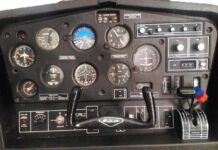Most instrument pilots flying today probably learned with conventional six-pack flight instrumentation. But, that’s changing. Rare is a new aircraft available without EFIS and popular shops are installing glass retrofits nearly as fast as they’re installing ADS-B systems. Do you need EFIS? Should you consider upgrading your six-pack panel to a fancy electronic package?
Like so much in life, the discriminating answer to that question is, “It depends.” Let’s look at some pros and cons.
EFIS is more reliable. With essentially no moving parts, there’s almost nothing that can wear out. Yes, EFIS failures do happen, sometimes spectacularly, but those failures are less common and usually more immediately noticeable than with spinning-mass gyro instruments.
EFIS improves your scan. With all the information right in front of you, it’s not necessary to move your eyes around much to get the basics. Yeah, there’s still an EFIS scan you’ve got to maintain, but moving your eyes a couple inches back and forth within one display is a lot easier than trying to assimilate the data spread across six disparate instruments over about 65 square inches of panel.
EFIS improves your situational awareness. There’s so much more information on a PFD, especially with SynVis and terrain. When that’s accompanied by an adjacent MFD, situational awareness requires little more than just looking at the picture.
A retrofit EFIS is far from a financial no-brainer. EFIS is expensive. With even a simple PFD running $10,000 and up, EFIS requires a real financial commitment. Reliability? Okay, but spinning gyro failures are generally more predictable and less catastrophic than a sudden red X.
What if you don’t fly serious IMC, just using your instrument rating to punch through the occasional layer or get into the airport slightly below VMC? If you’re well experienced and accomplished with the basic six pack, your scan is just fine. Perhaps you even supplement that with a tablet or just the map page on your navigator, giving you all the situational awareness you need.
With these factors and more in mind, here’s my conclusion. Yes, EFIS gives you more to work with and significantly expands your overall image of the world around your aircraft. But if you don’t need that, if your flying doesn’t push the edges of the envelope and if you’re able to keep your skills and habits sharp with conventional instrumentation, then you needn’t be in a hurry to drop $20,000 or more into a complete EFIS solution; the payback isn’t there.
…unless you’re facing some major repairs. A failed HSI repair alone can run toward $10,000. That’s perhaps the time to take a look at the long-term value proposition and consider that an additional expenditure now—yes, still significantly more than just your repair costs—might produce some eventual savings along with that added capability.
So, bottom line: If you don’t think you need EFIS, you probably don’t. You needn’t rush out to buy that fancy glass. But, if your missions push the edges of the weather envelope or your panel is in need of serious repairs, it might be time to make the jump.




